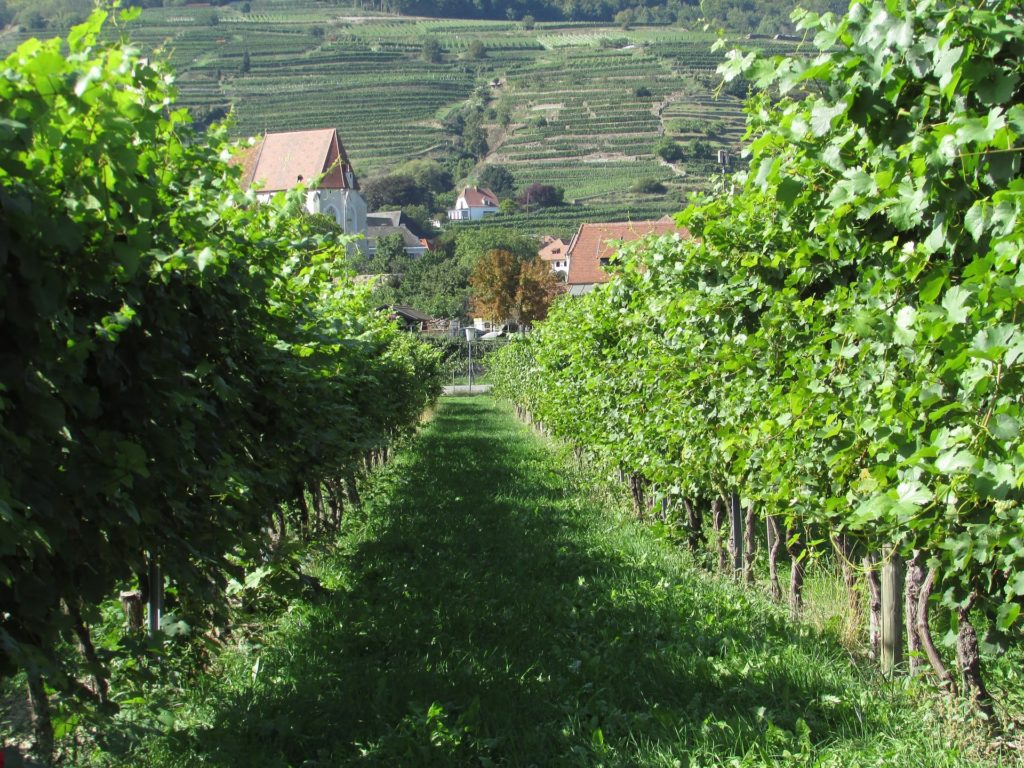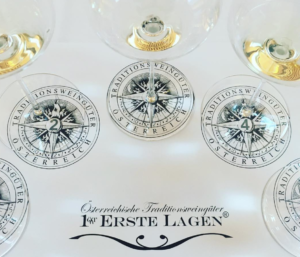Austria is one of the oldest wine countries in Europe, yet it is only just starting to define its grand cru system. In this interview with President of the Traditional Austrian Winemakers Association, Michael Moosbrugger, Amanda Barnes asks him about the history of Austrian wine, the formation and difference between Austria’s wine regions, and the future in appellation systems and their Premier Cru equivalent – the Erste Lage.
Watch the interview on our YouTube channel (it’s free for all!) or read the interview below:
History of Austrian wine, and its future – an interview with Michael Moosbrugger
Michael, can you give us an overview of the history of Austrian wine and the sort of production that the country had for many centuries.
Well, looking to, looking into the history of Austrian wine, we can go even back to Celtic times in Austria. So within Europe, Austria has one of the oldest wine histories, and we have findings in the eastern part of Austria, where we have proved that already the population around thousand years before Christ was into wine production (or whatever in these days wine was called). But basically, you can count on two major developments in the history of Austrian wine.
First of all, you have the time of the Roman Empire and we know that the Danube used to be the northern border of the Roman Empire. And due to all the Roman developments in Europe, the Roman time had a big impact in the developing of Austrian vines. The second most important period in the development of Austin wine areas and vineyards was the Middle Ages and the time of secularization, so the early 19th century. In these days, the monastic states were leading in the development of the vineyards in Austria due to a very simple reason that, in these days, monks were the only ones who could read and write, therefore they were the carriers of scientific research. And so basically monks were the ones who are trying to find out where are the best places to grow vines, how to improve the quality of winemaking, what are the best grapes to grow in these surroundings and in these climatical situations, and so on. The monasteries were the ones who had a really strong impact on the development of Austrian wine.
In the fourteenth century, Austrian wine production and vineyards were about four times the size of what it is today, but due to certain developments, for example, beer brewing was one of the reasons that winemaking declined, but there was also the reason that there was a little ice age actually in the late seventeenth century which had a big impact on the growing areas of Austria. However, I think that we could say that Austria has a really rich history of winemaking in Central Europe.
However, today, we also have a modern approach. And you find many family businesses in Austria, who on one side carry the tradition, and on the other side, are also motivated to try out new things, to go different ways. Sometimes I have even the impression that it’s a New World within the Old World. I think we’re combining history and traditions, but also with a new and modern, fresh way.

Tell me a bit about the structure, the vineyards and the wineries here, because you have many producers in Austria and not too many hectares of vines…
Exactly. Looking to the overall size of Austria, We’re looking after about 50,000 hectares, which is about the size of today’s Burgundy. For this area, there are about 3,000 producers, so small family businesses from five hectares to the biggest at 200 hectares, which in international terms, is quite small, actually.
Due to historical reasons, the vineyards here in Austria are quite fragmented, so that means every winemaker in Austria has a small parcel here and a small parcel there. So with the result that we’re working across 10 to 30 different single vineyards, and at the end of the day, we have to fit things together.
Also if you’re looking to the structure of the vineyards in Austria, we have more than 5,400 vineyards in Austria and even here in the Danube area it’s 2,500 vineyards. So the overall structure is quite complicated. We also looking to eighteen different growing areas.
However, on one side it’s complicated, on the other side, it’s not so complicated. I think the most important thing to know about Austria is that we have three main growing areas: you have to most southern part in an area that’s called Steiermark (or Styria in English), it’s an area where producers are concentrating on Chardonnay and Sauvignon Blanc.
And then you have the most eastern parts of Austria and everything that is south of the Danube, these are growing areas that are concentrating on red wine production and a little bit of sweet wine production. The red varieties is mainly Blaufrankisch and Zweigelt. Blaufrankisch is the main red grape variety, however, it’s an authentic, Austrian grape variety that became modern in the past thirty years and Blaufrankisch is a very old, traditional red variety that exists already for quite some centuries.
And then you have everything that is north of the Danube where producers are concentrating on the grape varieties of Grüner Veltliner and Riesling. This part north of the Danube counts for about two-thirds of Austria’s overall production. This is basically the reason why Austria is internationally known as a mainly white wine producing country.

Can you explain a bit about the Erste Lage classification that is currently taking place in Austrian wine?
Yeah. After the second world war Austria was in a transition mode from the field blends in the early days, or in the old days, to single-varietal planting with the results that for the past 50-60 years, the marketing for selling wine was based mainly on grape varieties. And since the early 2000s, we decided to go into an appellation system, for several reasons. Now, since early 2000s, we are trying to develop this appellation system for selling wine by its origin. And the result is that the origin is becoming the centre of attention.
Now, as I said before, in the Danube area we have 2,500 vineyards. As you can imagine, it’s impossible for anyone to know all these vineyards. We need a guiding system. So we know from other areas of the world that a classification system of vineyards is something that can be very helpful to consumers, to have a certain guideline, and so this is the reason why we started back in 1992 to form an association with the ambitious goal to establish a vineyard classification system in the Danube area.
As you can imagine, it’s not very easy to establish a vineyard classification system. This is not something that you can do from one day to another. It needs time. Even if you’re looking to the history of the classification systems in France, then you will see it took quite a long time until they were really established, until all the producers could identify with the system. So also, we believe that we need a lot of time to establish a classification system, and so we take it very seriously. It’s a generation project.
 We are about halfway through now. So we basically have been laying down the foundations of the classification. We’re working now on the classification of the Premier Cru, so the Erste Lagen vineyards. And in order to do that, every year we’re doing a presentation for professionals, for experts in order actually to help us in the classification process. We want to have their opinion, and this is why we are here in Grafenegg, actually, to all these wines from these vineyards that we have classified as Erste Lagen, or as Premier Cru.
We are about halfway through now. So we basically have been laying down the foundations of the classification. We’re working now on the classification of the Premier Cru, so the Erste Lagen vineyards. And in order to do that, every year we’re doing a presentation for professionals, for experts in order actually to help us in the classification process. We want to have their opinion, and this is why we are here in Grafenegg, actually, to all these wines from these vineyards that we have classified as Erste Lagen, or as Premier Cru.
And what’s the timeline?
It’s definitely a generation project. The next generation is already helping actually in the process, they are very important part of the classification process. So basically, we started with the classification process in 2009, and after close to ten years, I am expecting that at least for the next five to ten years, we will continue to classify the Premier Crus. When we’ve finished, in five to ten years, then we will classify the Grand Crus – from the smallest segment of the best 2-3% overall. That will last for another five to ten years, I believe. And then we will see how we will get the whole classification into the legislation.
And so far it’s only Grüner Veltliner and Riesling that are included?
Well, from our regulations, we’re not defining actually grape varieties, because the classification process is only dealing with the vineyards itself. However, the appellation – and this is the reason why Grüner Veltliner and Riesling are in connection with the classification – is that the appellation laws allow Grüner Veltliner and Riesling for wines of origin.
Are there any plans for other appellations that focus on red varieties to do the same?
It’s very likely. Other regions have implemented red wine in their appellation system. So in these areas, it’s very likely in the case that they start with the classification system.
My last question is a personal question. What are your favourite sites for Grüner and for Riesling? Do you have any preferred soils and regions within, any microsites that you would recommend?
My interest is in the different personalities of these vineyards. When we’re talking about the Danube area, certainly the sweet spot for Grüner Veltliner and Riesling in Austria, I think that we can distinguish between two archetypes of vineyard sites. On one side, we are looking to vineyards that are based on terraces along the Danube and the side rivers of the Danube. These vineyards are very dry, and have a high mineralisation in the soil. So these vineyards are ideal for Riesling production.
On the other side, we’re looking at vineyards that are based on loess, on clay, on loamy soils, so these vineyards have a good water supply and are ideal for Grüner Veltliner. This is one of the reasons why we do have two great varieties in this area because Grüner Veltliner and Riesling are complimentary. What one likes, the other doesn’t like, and the other way around. We need two grape varieties in order to cover the different vineyard sites and see the different personalities of the vineyard.
I’m not sure if I can say I have a preference for this or for that personality of a vineyard because I have a great appreciation to all of them. I think the most important thing is that a producer is honest to the vineyard and willing to try to work out the personality of these vineyards.
More features on Austria’s wine regions and Austrian wine:
- Tunnel Vision: Austria’s focus on single-site wines
- Terroir Essentials & Fast Facts on Austria’s wine regions and wine production
- Blaufränkisch wine guide and the Spitzerberg wine region
- Grüner Veltliner wine guide
- St Laurent wine guide
- Traisental wine region guide
- Zweigelt wine guide
- Carnuntum wine region guide
